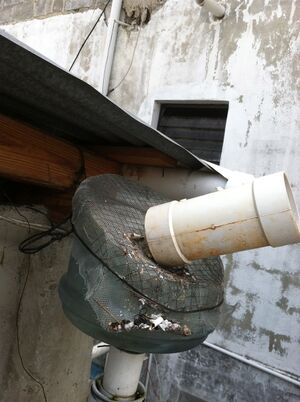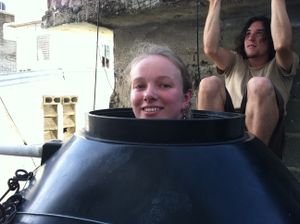Background
The Practivistas Domincana Program is currently a program involving Humboldt State University and UNIBE that takes place in Santo Domingo, Domincan Republic. The rainwater catchment system in La Yuca in Santo Domingo was first constructed in 2011. The water from this system was used for washing but was not potable. In 2012 the system was reconstructed and had different filters added in order to make the water potable. Now, in 2013, the water is still being used for washing but the water available for drinking is not being filtered, and therefore, it is not being used.
Objective
During the 2013 Practivistas Dominicana Program the objective is to make the La Yuca rainwater catchment system potable as well as easily accessible.
Literature Review
The following information was used to review and learn what is necessary to understand the concepts of design and implementation of rainwater catchment systems in the Dominican Republic.
Rainwater Catchment System
A rainwater catchment system is a system that collects, filters, and stores rainwater for community or household use. [1]
Roof Types
The type of construction material is important for a rainwater catchment system. Depending on what material is used for the roof, the collected water can be contaminated by carcinogens[1]. The roofing materials used in a rainwater catchment system should be chemically inert to keep contaminants out of the system. These materials include aluminum, fiberglass, plastic, and wood [2]. In addition to the roof material itself, the climate can influence the contaminate runoff depending on the material.
Metal roofs are commonly used for their smooth texture, Galvalume (55% aluminum, 45% zinc alloy coated sheet steel) is commonly used and can be treated with epoxy paint or a baked enamel coating. Clay and concrete materials are available for potable systems, clay and concrete are porous, however, which can lead to water loss, evaporation, and bacterial growth. Composite shingles should not be used for potable catchment systems due to the leaching toxins, in addition, wood shingles, tar and gravel are also know for leaching compounds and are therefore unsuitable. The most ideal roofing material for rainwater catchment is slate because of its smooth texture and lack of toxins. The cost of slate can be very high [3]. Various roof paints for roofs are suggested by the National Science Foundation to prevent leaching of carcinogens into the rainwater [4].
Water Treatment Techniques
Water from a rainwater catchment system must be treated before it is considered potable. Techniques for cleaning water vary depending on what filters are available and the contaminants involved. "No one piece of treatment manages all contaminants"[5].
| Treatment | Result |
|---|---|
| Screening | |
| Leaf screens and strainers | prevents leaves and other debris from entering the tank |
| Settling | |
| Sedimentation | settles out particulate matter |
| Activated charcoal | removes chlorine |
| Filtering | |
| Roof washer | eliminates suspended material |
| In-line/multi-cartridge | sieves sediment |
| Activated charcol | removes chlorine, improves taste |
| Microbiological treatment/Disinfection | |
| Boiling/distilling | kills microorganisms |
| Chemical treatments(chlorine or iodine) | kills microorganisms |
| Ultraviolet light | kills microorganisms |
| Ozonation | kills microorganisms |
| Nanofiltration | removes molecules |
| Reverse osmosis | removes ions(contaminants and microorgaisms) |
Water Quality
There are three criteria to having acceptable quality drinking water.
- No fecal bacteria
- No harmful chemicals
- No bad taste or smell
Rainwater catchment systems have commonly found contaminants due to the location and isolation of rooftops.
| Contaminant | Source | Risk of entering Rain Tank |
|---|---|---|
| Dust and Ash | Surrounding dirt and vegetation Volcanic activity |
Moderate:Can be minimized by regular roof and gutter maintenance and use of a first-flush device |
| Pathogenic Bacteria | Bird and other animal droppings on roof, attached to dust | Moderate:Bacteria may be attached to dust or in animal droppings falling on the roof. Can be minimized by use of a first-flush device and good roof and tank maintenance. |
| Heavy metals | Dust, particularly in urban and industrialized areas, roof materials | Low:Unless downwind of industrial activity such as a metal smelter and/or rainfall is very acidic (this may occur in volcanic islands) |
| Other inorganic Contaminants(e.g. salt from seaspray) |
Seaspray, certain industrial discharges to air, use of unsuitable tank and/or roof materials | Low:Unless very close to the ocean or downwind of large-scale industrial activity |
| Mosquito Larvae | Mosquitos laying eggs in guttering and/or tank | Moderate:If tank inlet is screened and there are no gaps, risks can be minimized. |
The Dominican Republic has the similar water quality standards as the World Health Organization (WHO).
| Parameter | |
|---|---|
| Surface Tension Agents | |
| Chlorides | |
| Chlorine | |
| Copper, Cu | |
| Iron, Fe | |
| Magnesium, Mg | |
| Manganese, Mn | |
| Calcium, Ca | |
| Phenol compounds such as phenol | |
| Sulfates, SO4 | |
| Zinc, Zn | |
| Total Dissolved Solids | |
| pH |
First Flush
The first flush in a rainwater catchment system is used to clear the roof of debris and airborne residue before it can reach the storage container. The gutter and leaf screen can keep larger debris out of the first flush[3]. Generally the first flush is meant to catch the first 10 min of rainfall, as that is a difficult volume to quantify one suggestion is to divert at least 10 gallons for every 1000 square feet of roof area, an Australian vendor suggests between 13 and 49 gallons per 1000 square feet of catchment surface. The two kinds of first flush diverters include just using a a PVC standpipe, when the standpipe fills the rainwater is diverted to the storage tank. The second kind is a the ball valve, a flouting ball within the PVC pipe shuts seals off the first flush volume and diverts the water.[10][6]
Climate
The Climate in Santo Domingo is tropical, with year round high humidity, warm temperatures, and varying rainfall. Santo Domingo receives an annual average rainfall of 57 inches. During the wet season (May - October) Santo Domingo receives between 5.5-7.4 in of precipitation monthly. During the "dry" season there are 2.1-3.9 inches of monthly precipitation. The annual temperature remains relatively constant year round, ranging from 24.4-27.1 °C [11]
Criteria
| Criteria | Constraints | Weight (1-10) |
|---|---|---|
| Accessibility | ||
| Level of Maintenance | ||
| Water Demand | ||
| Educational | ||
| Safety | ||
| Time | ||
| Materials | ||
| Cost | ||
| Durability |
Timeline
June 10th 2013
-Discussed plan of action
- Find water testing kits
- Discuss what is wrong with the current configuration
- Figure out questions to ask Aswaldo (Disassemble? Maintenance?)
-Found out UNIBE does not have any water testing kits.
-UNIBE normally has a professor take water samples to USAD (809)535-8273
-An alternative location for water testing is CAASD
June 11th 2013
-Email with contact information of USAD water lab was recived.
| For water quality analysis/PARA ANALISIS DE CALIDAD DEL AGUA Instituto de: Química de Microbiología y Parasitología UASD. |
-Checked the hardware store next to super national for first flush ideas and paint. The correct paint was not found
June 12th 2013
- Went to PURADOM (water filter store, 27 de Febrero and Lincoln) to drop off water samples
- Results should be ready June 14 or 15.
- Inspected the entirety of the system
- Disassembled and cleaned each component
| Image | Dissassembling and Cleaning |
|---|---|
 |
The current condition of first screening |
 |
Simone helped us Clean out the Tinaco |
June 13th 2013
- The hardware store next to Super National does not have any 3 or 4 inch quick releases.
- They do have 4 inch pipe that they can cut to size.
July 14th 2013
- Finished cleaning the Tinaco
- Talk with the director and set up a meeting for Monday June 17th at 4 PM.
July 15th 2013
- Bought supplies for the first flush
- Started first flush assembly
July 16th 2013
- Continued working on first flush
| Date | Task | Responsibility | ||||||
|---|---|---|---|---|---|---|---|---|
| June 17 | Finish putting together first flush, discuss designs, research filters and water pressure and solar pumps | Tanja and Andres | ||||||
| June 18 | begin purchasing materials for bottom portion | Tanja and Andres | ||||||
| June 19 | Start Constructing - buy filters/Paint | Tanja and Andres | ||||||
| June 20 | Cement Parts together | Tanja and Andres | ||||||
| June 21 | Test full system- if tinaco is full | Tanja and Andres | June 22 | Extra Maintenance | Tanja and Andres | June 23 | go to Las Malvinas to evaluate system | Tanja and Andres |
References
- ↑ 1.0 1.1 Palau Catchment Manual http://ag.arizona.edu/region9wq/pdf/Palau_catchmentmanual.pdf
- ↑ Rainwater harvesting from rooftop catchments http://www.oas.org/dsd/publications/Unit/oea59e/ch10.htm
- ↑ 3.0 3.1 3.2 Texas water harvesting manual http://www.twdb.state.tx.us/publications/reports/rainwaterharvestingmanual_3rdedition.pdf
- ↑ National Science Foundation approved list of paints http://www.nsf.org/Certified/Protocols/Listings.asp?TradeName=&Standard=P151
- ↑ University of Nebraska, Drinking Water Treatment: Sediment Filtration http://www.ianrpubs.unl.edu/live/g1492/build/g1492.pdf
- ↑ 6.0 6.1 WATER QUALITY OF RAINWATER HARVESTING SYSTEMS http://www.pacificwater.org/userfiles/file/MR0579.pdf
- ↑ ANTEPROYECTO II NORDOM 64 (3ra. Rev.)http://www.indocal.gob.do/LinkClick.aspx?fileticket=tLwTVMJm7oY%3D&tabid=114&mid=578
- ↑ WHO World Health Organization Water Quality PDF http://www.who.int/water_sanitation_health/dwq/gdwq0506.pdf
- ↑ Dominican Republic water quality http://www.temasactuales.com/laws_policies/legislation_Dominican%20Repub.html
- ↑ First Screening video example http://www.youtube.com/watch?v=mkeBlECXETQ&feature=endscreen
- ↑ World Meteorological Organization http://worldweather.wmo.int/132/c00281.htm